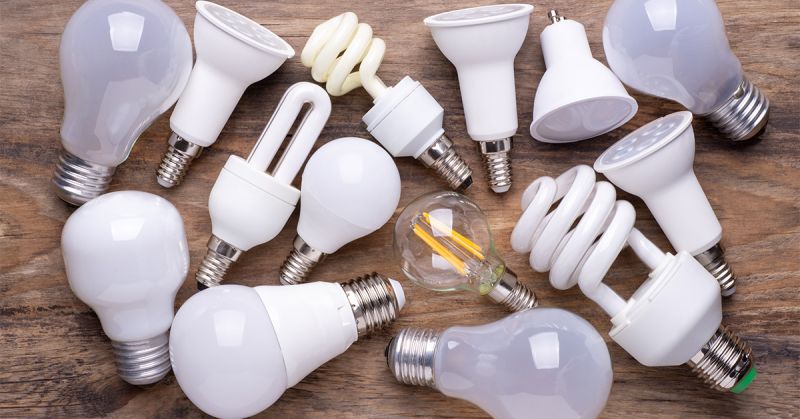
What You Need to Know About the Light Bulbs Used to Brighten Up Your Home
Tallahassee-area Homeowners have been lighting their homes with incandescent light bulbs for more than 120 years, but that form of lighting will soon dim. In April, the Biden Administration issued new rules that will force manufacturers to phase out incandescent bulbs before an outright ban on their sale in July 2023. Because the rules are based on energy efficiency, it also effectively ends the production and sale of most halogen lighting (a type of incandescent lighting).
What’s a Florida homeowner to do? With no more incandescent bulbs, what light bulbs should homeowners turn to for illuminating the various rooms in their house? Well, the electrical experts at Tallahassee-based Meeks Electrical Services know a thing or two about lighting and can offer you some recommendations on light bulb options. Read on to learn more about these options, the differences between them, and how to best use them to light your home’s rooms.
Your Current Lighting Options
Incandescent (including halogen)
Even though you’re not going to be able to purchase any incandescent light bulbs after July 2023, existing bulbs can and will continue to be used until the very last one burns out. While the life expectancy of most incandescent bulbs is one to two years, a four-watt bulb has been continuously burning in a California fire station since it was installed in 1901.
While not energy efficient—almost 90% of their energy is converted to heat—incandescent bulbs are inexpensive and emit warm ambient light that enhances decors and skin tone. The lighting quality is so good that many people are expected to stock up on incandescent bulbs prior to the ban.
Compact Fluorescent (CFLs)
While the technology had been experimented with since the 1940s, CFLs did not become commercially available at scale until the late 1990s. While CFLs can cost 3-10 times more than incandescent equivalents, they use about 30% less energy and typically last 8-10 times longer. The biggest consumer complaint about CFLs is that they emit harsh light, though producers have introduced newer versions designed to deliver warmer tones. Most CFLs take time to power up to full brightness, and many models will not work with dimmer switches.
Note that CFLs could get phased out in the future like incandescent bulbs due to new standards under consideration by the U.S. Department of Energy. Some manufacturers have already stopped CFL production to focus on light-emitting diode lighting.
Light-Emitting Diode (LEDs)
First developed in the early 1960s, the technology of LEDs only advanced enough to make the lighting aesthetically and commercially feasible in the last decade. While they represent the most expensive option, they use 10 times less energy than incandescent lights and last 30 times longer. The cost of LED bulbs has been dropping in concert with the significant uptick in commercial sales.
LEDs represent the best option for duplicating the quality of light produced by incandescent bulbs. You might have to experiment with different types to match LED light with your preferred incandescent light, as LEDs’ brightness is measured in lumens rather than watts.
Understanding Light Bulb Factors That Affect Room Lighting
Three factors affect how a light bulb affects the appearance of a room: brightness, temperature, and color rendering index (CRI).
Brightness is measured in lumens, while the amount of energy it takes to produce the lumens is measured in watts. Generally speaking, we’re used to using 100-watt incandescent bulbs for areas that need bright lighting and 40- to 60-watt bulbs for those areas needing less light. A 14-watt CFL and 800-lumens LED are roughly equivalent to a 60-watt incandescent.
Temperature is measured in Kelvins (K) and most light bulb labels today refer to “color temperature,” with the lower temperature ranges indicating a warmer tone. Typical incandescent light bulbs receive a color temperature measurement of between 2700K-3000K, while 4000K-5000K marks whiter tones.
The CRI measures how an object’s coloring appears under the light bulb compared to how its coloring looks under ideal lighting, with higher values indicating the most realistic representation of the color. In general, incandescent bulbs are ranked with a CRI value of 100, CFLs range from 50 to 98, and LEDs range from 80 to 90. Any bulb with a CRI above 80 provides lighting that works well with colors, but look for higher values for areas that need the most accurate rendition of color.
Contact Meeks for Your Home Lighting Needs
If you’re having difficulties casting the perfect lighting throughout the different rooms in your home, Tallahassee-based Meeks Electrical Services would be happy to consult with you. We have extensive experience helping customers determine the best lighting for their interior spaces and offer various lighting installation options, among its many services. For all your Tallahassee-area residential and business electrical needs, contact Meeks today at (850) 575-5241.